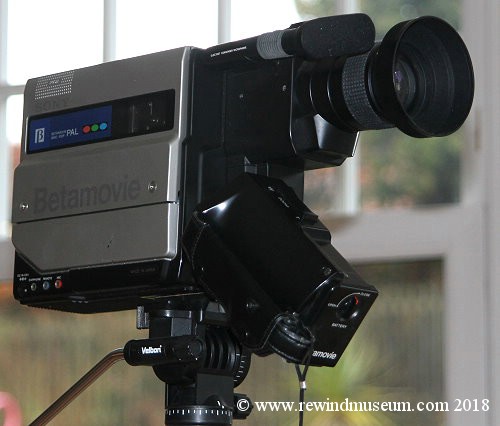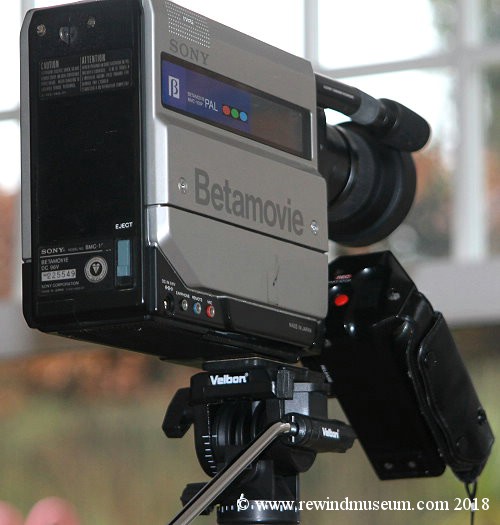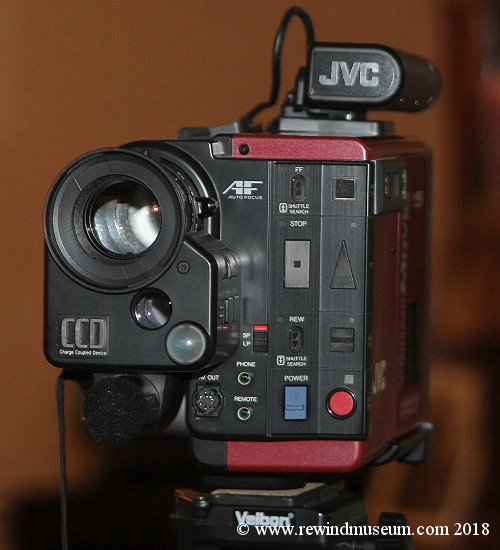Museum of early consumer electronics and 1st achievements
www.rewindmuseum.com
1983. Sony BMC100P. The very 1st Camcorder.






This is a Sony BMC100P Betamax camcorder from 1983 complete with shoulder strap and original carry case.
It was the world's first camcorder. Before it was introduced, the camera and portable VCR were separate items.
The camera was held and the vcr was hung over the shoulder and connected to the camera with a cable. This
was the first time the recorder was actually built into the camera to make a camcorder. It used the Betamax
format and was labelled a "Betamovie" camcorder. It is interesting that the viewfinder is not electronic,
it is an optical system which lets you see exactly what you're recording by looking directly through the
lens, via a system of mirrors and prisms just like an SLR still camera. The BMC-100 was the first combined
camera and recorder to go on sale and for the size of tape, it is a very compact and well designed unit
Sony's Betamax video uses 1/2" home video cassettes. Betamax video recorders were also sold by Toshiba,
Pioneer, Sanyo, Aiwa, NEC, Zenith Electronics, and WEGA. The Betamax format was at it's most popular in 1983,
gaining almost a third of the UK video recorder market. Sanyo celebrated it's VTC5000 as the top selling UK
video recorder, however, by 1985 the market had moved sharply towards VHS. From Sony's website in 2018 -
"The first "Betamovie" camcorder, combining a video camera and Betamax deck. In the camera section, a small
(half-inch) and light SMF Trinicon pickup tube offers excellent sensitivity. In the recording section, an
omega loading system cut the head drum diameter nearly in half. These innovations represented the most
advanced technology of the day, making the "Betamovie" the world's smallest and lightest camcorder.
This model also introduced the idea of housing the camera battery in the grip".
For anyone who is an experienced camera operator like myself, you notice the big ommision on this camera
is the lack of a carry handle on the top. How Sony never thought of that is beyond me. It is not just
for carrying the camera, Whilst shooting is mainly done from the shoulder, many low down shots are taken
using the handle to point and control the camcorder. Indeed many later camcorders have a duplicate start
stop button on the handle to assist shooting from that position.

1984. The JVC GR-C1. 1st VHS C camcorder.





The VHS system was invented by JVC and in 1984 they used their existing VHS-C (compact cassette) system to
produce a VHSC camcorder. They did not bother with a full size VHS system camcorder at this time and so this
is not only the 1st VHSC camcorder, it was also the first camcorder using the VHS system. It was left to
Panasonic the following year in 1985 to introduce a full size VHS tape camcorder, the
M1. Full size camcorders
were aimed at the semi professional marked and VHSC the home consumer. (Although I never used an M1 I did use
Panasonic's MS1 professionally. That was Panasonics first full size SVHS camcorder. Following the MS1 I also used
the MS2, the MS4 and the
JVC KY19). The VHSC tape could be put into a VHS/VHSC adapter cassette and
played back on a full size VHS VCR. Since most people would have a VHS VCR at home, the new compact VHSC
camcorder tapes were compatible with the larger VCR. This camcorder was voted as one of the top 100 gadgets
of all time and it is the same model which was used in one of the 1980s most famous films with "Marty McFly"
in "Back To The Future staring Michael J Fox. This camcorder is complete with accessories manual and carry case.
1985. Panasonic M1. The first full size VHS camcorder.







The first VHS (VHSC) camcorder was the JVC
GR-C1 in 1984 (above) but the first full size tape VHS camcorder
was this Panasonic M1. Top left you can see it without a battery clipped to the back and top right with the
battery clipped on. Also notice it came with an after-market light on the top. The M1 camcorder would have
been aimed at the semi professional market. Videographers, wedding videos, corporate events etc. The Panasonic
MS1 was the next big step forward after this camcorder as the MS1 used the SVHS system which offered 400
lines of resolution rather than the VHS system of 240-270 lines.

1985. Sony CCD-M8E. 1st 8mm camcorder.


 Video 8 / 8mm compact cassette Sony "Handycam"
Video 8 / 8mm compact cassette Sony "Handycam"
It is interesting to see this new light-weight camcorder announced in the Sept. 1985 issue of Popular Science Magazine.
This compact tape recording system from Sony used a video tape which was 8mm in width in a compact cassette. From
Sony's web site in 2018 -"Lightest camcorder in the world when launched, at 1.0 kg. This model is exclusively for
recording. The CCD-M8 marked the start of the Handycam series. It is significantly smaller than the CCD-V8. The lens
barrel has a sliding cover, and the grip incorporates the battery compartment. Offering convenience and simplicity
approaching a fully automatic still camera, the premier Handycam was exceptionally easy to operate with one hand"

1988. Amstrad Fidelity Videomatic VMC 100



Amstrad's 1st VHSC camcorder - cheapest camcorder available. Amstrad liked to produce cheap and cheerful
products for the mass market. Camcorders were expensive and this was a no frills camcorder for only. Better
camcorders eventually dropped in price but at the time this was popular.
 Making a donation.
Making a donation.
The Rewind Museum is a non-profit making endeavour. The web site and the touring exhibitions are run on
a voluntary basis. Donations,
not money, just old items you no longer want, are always welcome.
If you have something that you think would be of interest, please contact us with the details.
We can send in a courier to pick them up. (Even an international courier). Thank you.
Please note - The Rewind Museum site has been archived by the British
Library so that future generations can always access the site's content.
To talk to us about making a donation please go to - "
making a donation".
Are you interested to read about a 10 year + restoration of a classic vehicle?
If so go to -
www.1952chevytruck.com
 The 1952 The 1952 Chevy truck web site.
The 1952 The 1952 Chevy truck web site.

Web site copyright © 2018 Vision International. All rights reserved.
For all questions & comments about this site's content contact Dave at Rewind Museum.

































